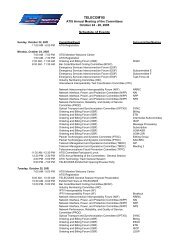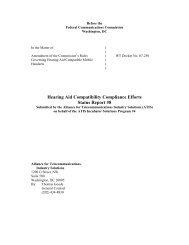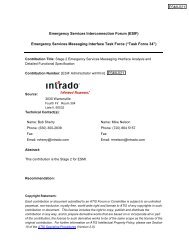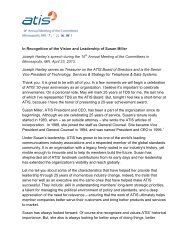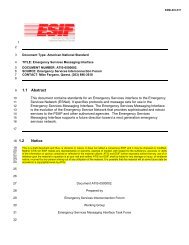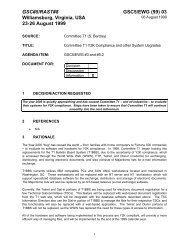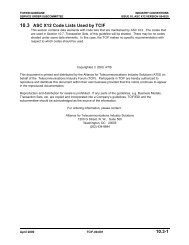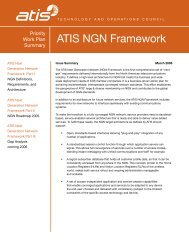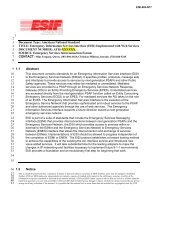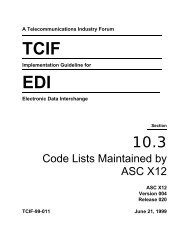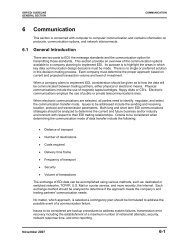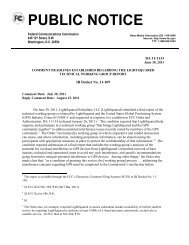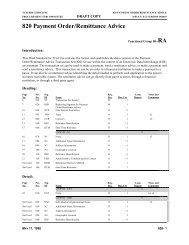Reinventing DSL with Copper Pair Bonding - ATIS
Reinventing DSL with Copper Pair Bonding - ATIS
Reinventing DSL with Copper Pair Bonding - ATIS
Create successful ePaper yourself
Turn your PDF publications into a flip-book with our unique Google optimized e-Paper software.
<strong>Reinventing</strong> <strong>DSL</strong><br />
<strong>with</strong> <strong>Copper</strong> <strong>Pair</strong> <strong>Bonding</strong><br />
Wednesday, October 26<br />
1:30 – 3:00 p.m.<br />
Venetian Ballroom I<br />
Technology Forum at TELECOM ‘05
<strong>Reinventing</strong> <strong>DSL</strong> <strong>with</strong> <strong>Copper</strong><br />
<strong>Bonding</strong><br />
<strong>ATIS</strong> Technology Conference<br />
Telecom 05<br />
October 26, 2005
<strong>Reinventing</strong> <strong>DSL</strong>: Higher Speeds<br />
• Competition<br />
– Cable<br />
– 3G Wireless<br />
• Migration<br />
– From 1.5 Mbps to 15 Mbps or more<br />
• Standards<br />
– Need cost-effective, standard solutions
• Inverse Multiplexing<br />
– Payload <strong>Bonding</strong><br />
<strong>Bonding</strong> Defined<br />
– Combining the payloads of 2 or more <strong>DSL</strong> links into a<br />
single “fat pipe”<br />
– Many Standards available<br />
• MLPPP (RFC 1990) – relies on underlying HDLC<br />
• IMA – Inverse Multiplexing for ATM<br />
• T1.427, G.998<br />
– .01/.1: ATM Cell <strong>Bonding</strong><br />
– .02/.2: Ethernet Transport (64/65 TC)<br />
– .03/.3: Time Division Inverse Multiplexing (TDIM)<br />
• IEEE 802.3ah – Ethernet bonding <strong>with</strong> SH<strong>DSL</strong>/V<strong>DSL</strong>
What <strong>Bonding</strong> <strong>with</strong> What <strong>DSL</strong><br />
MLPPP<br />
IMA<br />
TDIM<br />
64/65 Ethernet<br />
<strong>Bonding</strong><br />
ATM <strong>Bonding</strong><br />
Theoretically,<br />
any bonding<br />
works <strong>with</strong> any<br />
<strong>DSL</strong><br />
DS-1<br />
SH<strong>DSL</strong><br />
V<strong>DSL</strong>1/2<br />
A<strong>DSL</strong>/ A<strong>DSL</strong>2+
What <strong>Bonding</strong> <strong>with</strong> What <strong>DSL</strong><br />
MLPPP<br />
IMA<br />
TDIM<br />
64/65 Ethernet<br />
<strong>Bonding</strong><br />
ATM <strong>Bonding</strong><br />
DS-1<br />
SH<strong>DSL</strong><br />
V<strong>DSL</strong>1/2<br />
A<strong>DSL</strong>/ A<strong>DSL</strong>2+<br />
In practice, these mappings are the most common
Beyond Standards<br />
• Multiple Input Multiple Output (MIMO)<br />
– Can be applied mostly independent of payload<br />
bonding method<br />
– Rates can be boosted through<br />
• In-Domain Crosstalk Cancellation<br />
• Out-of-Domain Crosstalk Compensation<br />
• <strong>Pair</strong>-diverse Coding<br />
– Out of domain gains can vary widely<br />
• Most gain requires large (8-12 pairs) group size<br />
• Depends on # and type of other system and noise
Panelists<br />
• Jürgen Lison, Alcatel<br />
– <strong>Bonding</strong> and A<strong>DSL</strong>2+<br />
• Rouben Toumani, Ikanos<br />
– <strong>Bonding</strong> and V<strong>DSL</strong>2<br />
• Gary Tennyson, BellSouth<br />
– <strong>Bonding</strong> Deployment Considerations
<strong>Reinventing</strong> <strong>DSL</strong> <strong>with</strong> <strong>Bonding</strong><br />
Jürgen Lison, Alcatel<br />
All rights reserved © 2005, Alcatel
Topics<br />
• Why bond<br />
• Capture new customers <strong>with</strong> extended reach<br />
• Address business needs <strong>with</strong> symmetrical services<br />
• Offer triple play services<br />
• Shannon’s Law and market realities<br />
• Bonded A<strong>DSL</strong>2+ fills the gaps<br />
• <strong>Bonding</strong> challenges and solutions<br />
• Summary<br />
<strong>Reinventing</strong> <strong>DSL</strong> – USTA 2005 | Page 2<br />
All rights reserved © 2005, Alcatel
How some people bond lines<br />
Key features:<br />
• Poor scalability<br />
• High fixed investment<br />
costs<br />
• Safety concerns<br />
• And not very flexible<br />
<strong>Reinventing</strong> <strong>DSL</strong> – USTA 2005 | Page 3<br />
All rights reserved © 2005, Alcatel
Why Bond A<strong>DSL</strong>2+<br />
• At any REACH – Double RATE (DS, US)<br />
• Generally Available and shipping TODAY<br />
• Stable, standard technology<br />
• Chip synergies <strong>with</strong> legacy A<strong>DSL</strong><br />
• Greater range of marketable bandwidths than<br />
single pair V<strong>DSL</strong>/V<strong>DSL</strong>2<br />
<strong>Reinventing</strong> <strong>DSL</strong> – USTA 2005 | Page 4<br />
All rights reserved © 2005, Alcatel
Expanding the customer (and revenue) base for <strong>DSL</strong><br />
Extending Reach<br />
• Bonded A<strong>DSL</strong>2+ doubles data<br />
rates at any given reach<br />
• Customers previously unable to<br />
qualify for <strong>DSL</strong> – now qualify<br />
Symmetrical Services<br />
• Double upstream bandwidth<br />
• T1 replacement opportunity<br />
• Target SMB customers<br />
• Competitive positioning over cable<br />
<strong>Reinventing</strong> <strong>DSL</strong> – USTA 2005 | Page 5<br />
All rights reserved © 2005, Alcatel
Delivering the Triple Play<br />
<strong>Reinventing</strong> <strong>DSL</strong> – USTA 2005 | Page 6<br />
All rights reserved © 2005, Alcatel
How much bandwidth is needed at the home<br />
Depends on the services offered<br />
• Video<br />
• High bandwidth and high QOS<br />
• HD and SD<br />
• Multiple STBs, DVRs, and PIPs<br />
• Voice<br />
• Low bandwidth but high QOS<br />
• Data<br />
• High bandwidth but bursty<br />
• Some QoS<br />
• Supply-side product:<br />
“If you build it, they will come.”<br />
100+<br />
Mbps<br />
40<br />
Mbps<br />
20<br />
Mbps<br />
HSI<br />
HD DVR 2<br />
HSI<br />
Tier 2<br />
“Table Stakes”<br />
HSI<br />
Tier 1<br />
SD<br />
SD<br />
HD<br />
Still<br />
More<br />
Data<br />
SD TV 3<br />
Triple Play Market<br />
More<br />
Data<br />
Data<br />
DVR 1<br />
TV 2<br />
TV 1<br />
<strong>Reinventing</strong> <strong>DSL</strong> – USTA 2005 | Page 7<br />
All rights reserved © 2005, Alcatel
IPTV and interactivity<br />
IPTV drives interactive services<br />
• Multiple Picture-in-picture streams<br />
• Online gaming<br />
• Video on Demand<br />
Services drive more bandwidth<br />
• Multiple HD streams<br />
• Quick response video games<br />
Competition drives more bandwidth<br />
• Cable is and will continue to differentiate on<br />
“perceived” data bandwidth<br />
Order Print<br />
^<br />
The market requires an access network transformation<br />
<strong>Reinventing</strong> <strong>DSL</strong> – USTA 2005 | Page 8<br />
All rights reserved © 2005, Alcatel
Single <strong>Pair</strong> A<strong>DSL</strong> or A<strong>DSL</strong>2+ won’t deliver the Triple Play<br />
• Better data rates are<br />
possible<br />
80<br />
70<br />
FTTC<br />
FTTN<br />
A<strong>DSL</strong>2+<br />
• Basic video can be<br />
delivered, but HDTV<br />
and any cable<br />
competition hurts<br />
marketability<br />
• DLC loop lengths are<br />
not IPTV-enabled<br />
<strong>with</strong> A<strong>DSL</strong>2+<br />
Data Rate (Mbps)<br />
60<br />
50<br />
40<br />
30<br />
20<br />
Triple Play Market<br />
A<strong>DSL</strong><br />
Triple<br />
Play<br />
Bandwidth<br />
10<br />
0<br />
0 1,000 2,000 3,000 4,000 5,000 6,000<br />
Loop Length (ft)<br />
<strong>Reinventing</strong> <strong>DSL</strong> – USTA 2005 | Page 9<br />
All rights reserved © 2005, Alcatel
V<strong>DSL</strong>2 is one solution<br />
• Enables complete<br />
triple play over<br />
copper<br />
80<br />
70<br />
FTTC<br />
FTTN<br />
V<strong>DSL</strong>2<br />
A<strong>DSL</strong>2+<br />
• Simple approach:<br />
• One pair<br />
• Easy management<br />
• New technology<br />
• Economics of scale<br />
• Higher impact from<br />
interference<br />
Data Rate (Mbps)<br />
60<br />
50<br />
40<br />
30<br />
20<br />
10<br />
Triple Play Market<br />
A<strong>DSL</strong><br />
Triple<br />
Play<br />
Bandwidth<br />
0<br />
0 1,000 2,000 3,000 4,000 5,000 6,000<br />
Loop Length (ft)<br />
<strong>Reinventing</strong> <strong>DSL</strong> – USTA 2005 | Page 10<br />
All rights reserved © 2005, Alcatel
Bonded A<strong>DSL</strong>2+ transforms the copper access plant<br />
• Provides the widest<br />
range of options for<br />
Triple Play<br />
• Synergies <strong>with</strong><br />
existing A<strong>DSL</strong><br />
• Chipsets<br />
• Power profile<br />
• Complexities<br />
• Multiple pairs not<br />
available everywhere<br />
• Managing data across<br />
two pairs<br />
• B/OSS issues to be<br />
resolved<br />
Data Rate (Mbps)<br />
80<br />
70<br />
60<br />
50<br />
40<br />
30<br />
20<br />
10<br />
0<br />
FTTC<br />
FTTN<br />
Triple Play Market<br />
0 1,000 2,000 3,000 4,000 5,000 6,000<br />
Loop Length (ft)<br />
V<strong>DSL</strong>2<br />
Bonded A<strong>DSL</strong>2+<br />
A<strong>DSL</strong>2+<br />
A<strong>DSL</strong><br />
Triple<br />
Play<br />
Bandwidth<br />
<strong>Reinventing</strong> <strong>DSL</strong> – USTA 2005 | Page 11<br />
All rights reserved © 2005, Alcatel
Execution presents challenges…that have solutions!<br />
Challenges<br />
• Finding additional copper pair<br />
between subscriber and <strong>DSL</strong>AM<br />
Solutions<br />
• Most homes have two pair for legacy POTS<br />
requirements<br />
• System level bonding eliminates <strong>DSL</strong>AM<br />
rewiring: use the next pair, regardless of<br />
position<br />
• New “<strong>Bonding</strong>-ready” CPE<br />
required<br />
• OSS systems not currently<br />
supporting bonding<br />
• IPTV: New CPE will be required regardless<br />
ER<strong>DSL</strong>: New customers need CPE<br />
• OSS is already designed to support two lines<br />
per customers<br />
• Element management tools enable efficient<br />
bonding management <strong>with</strong>in current operations<br />
practices and systems<br />
<strong>Reinventing</strong> <strong>DSL</strong> – USTA 2005 | Page 12<br />
All rights reserved © 2005, Alcatel
Integrated bonding <strong>with</strong> service provider’s NMS/OSS<br />
systems<br />
• Operations procedures are the SAME as<br />
currently employed<br />
• TL1 upstream interface for flow through<br />
provisioning, performance monitoring, and<br />
alarm surveillance<br />
• Tools to examine equipment inventory and<br />
customer status<br />
• Easy to use GUI for troubleshooting, and<br />
maintenance purposes<br />
• Simplicity of system-level bonding<br />
• OSS does not have to worry about<br />
“which two lines to pair”<br />
• “Any line” to “any line” capability<br />
• Integration into existing element management<br />
<strong>Reinventing</strong> <strong>DSL</strong> – USTA 2005 | Page 13<br />
All rights reserved © 2005, Alcatel
Summary<br />
<strong>Bonding</strong> <strong>Copper</strong> <strong>Pair</strong>s<br />
• Enables triple play services over copper and node/curb distances<br />
• Provides means to expand residential <strong>DSL</strong> customer base<br />
• Allows competitive SMB service offerings<br />
Operational challenges have clear solutions<br />
All of this is available – TODAY<br />
<strong>Reinventing</strong> <strong>DSL</strong> – USTA 2005 | Page 14<br />
All rights reserved © 2005, Alcatel
www.alcatel.com<br />
<strong>Reinventing</strong> <strong>DSL</strong> – USTA 2005 | Page 15<br />
All rights reserved © 2005, Alcatel
<strong>Reinventing</strong> <strong>DSL</strong>:<br />
Delivering 25Mbps & Beyond Over Existing <strong>Copper</strong> <strong>Pair</strong>s<br />
Rouben Toumani, PhD.<br />
Ikanos Communications<br />
Ikanos Confidential
Overview<br />
» The copper access network is evolving driven by new<br />
applications and services<br />
» <strong>DSL</strong> technologies have evolved to meet the need<br />
– A<strong>DSL</strong> -> A<strong>DSL</strong>2+ -> V<strong>DSL</strong> -> V<strong>DSL</strong>2<br />
– V<strong>DSL</strong>2 has emerged as a universal <strong>DSL</strong> technology to serve multiple<br />
deployment options in the access network<br />
– From Dial-up to Fiber-Fast Broadband Performance<br />
– From FTTP to Exchange-Based distances<br />
» Promising new technologies on the horizon<br />
– <strong>Bonding</strong> of two or more pairs of copper<br />
• Great performance enhancement <strong>with</strong> existing technologies<br />
• Applies to multiple physical layers (A<strong>DSL</strong> to V<strong>DSL</strong>2)<br />
– Dynamic Spectrum Management (DSM)<br />
– Noise cancellation techniques (MIMO)<br />
– Dynamic Noise Management<br />
2<br />
Ikanos Confidential
Fiber/<strong>Copper</strong> Deployment Scenarios<br />
Central<br />
Office<br />
FTTB – 1Kft<br />
Node<br />
MxU, FTTN<br />
50-100 Mbps<br />
Remote<br />
2 Miles<br />
3<br />
Ikanos Confidential<br />
FTTH
Telco Access Evolution<br />
30 MHz<br />
100M/100M,<br />
25M/5M<br />
V<strong>DSL</strong>, V<strong>DSL</strong>2<br />
Broadband<br />
2.2 MHz<br />
• Interactive Broadband<br />
• Triple-Play +<br />
25M/2M<br />
8M/800K<br />
4 kHz<br />
1.1 MHz<br />
Gen 1 (A<strong>DSL</strong>)<br />
Broadband<br />
Gen 2 (A<strong>DSL</strong>2+)<br />
Broadband<br />
• Streaming audio and video<br />
• Enhanced peer-peer sharing<br />
56K/28K<br />
Narrowband<br />
Dialup<br />
• Enhanced web access<br />
• Streaming audio<br />
• Basic web access<br />
• Email<br />
4<br />
1995 2000 2005<br />
Ikanos Confidential
Interactive Broadband: The Next Wave<br />
Media-rich,<br />
Multi-player<br />
Gaming<br />
12 Mbps/channel HDTV<br />
Interactive Features,<br />
Personalized Services<br />
Wideband<br />
VoIP<br />
4 Mbps<br />
bi-directional<br />
4x-10x Faster<br />
Web Access,<br />
Remote<br />
Access<br />
of<br />
Home PC<br />
Enhanced Video + Audio,<br />
Video Surveillance<br />
Video Blogging,<br />
Video Upload,<br />
Digital Photo Upload<br />
5<br />
Ikanos Confidential
V<strong>DSL</strong>2: The Universal <strong>DSL</strong> Technology<br />
» Cost-effective fiber bandwidth over copper<br />
– Capability to deliver 100 Mbps symmetric services<br />
– Supports triple-play<br />
– Supports interactive services (enhanced upstream)<br />
– Designed for integration <strong>with</strong> IP packet based networks<br />
» Built on solid, proven DMT technology<br />
– 100 Million lines and counting!<br />
– Seamless multi-mode (A<strong>DSL</strong>/A<strong>DSL</strong>2/A<strong>DSL</strong>2+/V<strong>DSL</strong>/V<strong>DSL</strong>2)<br />
» Key technology enhancements<br />
– Wider spectrum utilization up to 30 MHz<br />
– Trellis Coded Modulation (TCM)<br />
– Deployment-optimized implementations: Profiles<br />
– PSD shaping for co-existence <strong>with</strong> the deployed services<br />
– Optional U0 band expanded to 276 kHz for long reach<br />
6<br />
Ikanos Confidential
Technology Enhancements<br />
Bonded V<strong>DSL</strong>2<br />
» V<strong>DSL</strong>2 <strong>Copper</strong> <strong>Pair</strong> <strong>Bonding</strong><br />
– Standards (ITU-T G.998 / <strong>ATIS</strong> T1.427 series) compliant<br />
• Packet (Ethernet): Seamless integration into IP based networks<br />
• Also ATM for legacy networks and TDIM for DS3 transport<br />
– Data aggregation protocol above the Physical Layer<br />
• Offers greatest flexibility / optimized implementations<br />
» Market Drivers for Bonded V<strong>DSL</strong>2<br />
– Ensure ubiquitous service offering / geographic footprint<br />
– Commercial MTU’s, Residential MDU’s<br />
• Business: High reliability, guaranteed symmetric rates<br />
• Avoids copper ownership / building access issues<br />
– Single Family Residential<br />
• Consumer: Offer the highest broadband rates available<br />
• Perfect for deep fiber / PON network architectures<br />
7<br />
Ikanos Confidential
<strong>Bonding</strong> 2 pairs of V<strong>DSL</strong>2<br />
100.0<br />
90.0<br />
80.0<br />
70.0<br />
60.0<br />
V<strong>DSL</strong>2 Profile 12a<br />
•12 self-disturbers<br />
(99% worst case)<br />
•24 AWG<br />
Mbps<br />
50.0<br />
40.0<br />
30.0<br />
20.0<br />
10.0<br />
0.0<br />
0 1,000 2,000 3,000 4,000 5,000 6,000<br />
Loop Length (feet)<br />
Downstream<br />
Downstream (2 pairs bonded)<br />
Upstream<br />
Upstream (2 pairs bonded)<br />
8<br />
Ikanos Confidential
Technology Enhancements:<br />
DSM (Dynamic Spectrum Management)<br />
» Four Levels of DSM<br />
– Level 0: Nothing “hogs” the available wire line spectrum<br />
• In use today: Spectrum Management Rules (T1.417)<br />
• Systems shall not cause each other “significant degradation”<br />
– Level 1: Politeness = Near transmitter “speaks softly”<br />
• Transmits only the power needed for service offering<br />
• Especially useful for “near-far” problem<br />
– Level 2: Spectrum Balancing<br />
• Adaptively determines PSDMASK<br />
• Shorter loop uses higher frequencies <strong>with</strong> less penalty<br />
– Level 3: Vectoring = Intelligent Service Provider Network<br />
• Active management of both CO and CPE modems<br />
• Serious number crunching gains serious performance<br />
9<br />
Ikanos Confidential
Technology Enhancements:<br />
MIMO (Multiple Input Multiple Output)<br />
» Technology used in wireless networks<br />
» Now being introduced for copper bonded systems<br />
– Intra-network transport (Cell site backhaul, T1/T3 gap)<br />
– 12+ pairs bonded in end-to-end system, vector managed<br />
» The ultimate Level 3 DSM<br />
– Vectoring = true mitigation of NEXT and FEXT crosstalk<br />
– MIMO NEXT mitigation: US is easier<br />
• Co-located receivers seeking common enemy – exploits the<br />
alien crosstalk correlation across lines<br />
• Useful to create greater rate symmetry (better US)<br />
– DS more complex:<br />
• Must use transmitter pre-compensation<br />
• Pre-comp is based on data of varying accuracy<br />
10<br />
Ikanos Confidential
Summary<br />
» Drivers of copper access network evolution<br />
include:<br />
– Triple Play / HDTV delivery<br />
– Peer-to-peer applications requiring greater upstream<br />
» <strong>DSL</strong> technologies have evolved to meet the need<br />
– <strong>Bonding</strong> provides additional coverage<br />
– DSM & MIMO: active noise mitigation is the next step<br />
» V<strong>DSL</strong>2:<br />
– V<strong>DSL</strong>2 has arrived as the universal <strong>DSL</strong> technology<br />
– Ready to implement future technology enhancements<br />
11<br />
Ikanos Confidential
<strong>Reinventing</strong> <strong>DSL</strong> <strong>with</strong><br />
<strong>Copper</strong> <strong>Pair</strong> <strong>Bonding</strong><br />
October 26, 2005<br />
1<br />
Gary Tennyson<br />
BellSouth Telecommunications
Building a Competitive<br />
Broadband Network<br />
• New distribution areas – Fiber To The<br />
Curb (FTTC)<br />
• Base of existing distribution areas –<br />
Fiber To The Node (FTTN)<br />
• Both drive fiber deeper into the loop<br />
network<br />
2
Fiber To The Curb<br />
• Telephony and <strong>DSL</strong> service is supported,<br />
not an overlay<br />
• Fiber placed throughout a serving area as it<br />
is developed<br />
• Optical Network Units (ONU) provide for<br />
conversion from an optical to an electrical<br />
interface<br />
– Maximum Distance from ONU to a subscriber’s<br />
residence/business is 500 feet<br />
– Short drop allows us to take advantage of the<br />
very high data rates offered by V<strong>DSL</strong><br />
3
Fiber To The Node<br />
• New platforms will support the existing base<br />
of <strong>DSL</strong> lines<br />
– Large existing base of remote <strong>DSL</strong>AM’s could<br />
create a complex spectrum management<br />
problem in an overlay network<br />
– Multi-mode ports to support existing <strong>DSL</strong><br />
• Initial focus on A<strong>DSL</strong>2plus<br />
• Planning to use V<strong>DSL</strong>2 as we move forward<br />
• <strong>Bonding</strong><br />
4
What is <strong>Bonding</strong> <br />
• Provides for summing the capacity of two or<br />
more <strong>DSL</strong> lines<br />
– Involves multiple physical-layer transceivers<br />
– One data stream ‘seen’ by the user<br />
• Provides for greater data rates and/or<br />
operation on longer loops<br />
• Needed <strong>with</strong> A<strong>DSL</strong>2plus for data rates<br />
greater than about 12 – 18 Mbps in a multipair<br />
environment<br />
• Not unique to A<strong>DSL</strong>2plus<br />
5
Why Choose Bonded <strong>DSL</strong> <br />
• Decision requires insight into several areas:<br />
– <strong>DSL</strong> Rate/Reach<br />
– Distribution of loop lengths<br />
– Availability of vacant pairs<br />
• What is the targeted maximum data rate <br />
• What is the targeted coverage, i.e., what<br />
percent of loops should be capable of<br />
supporting the targeted data rate <br />
6
<strong>DSL</strong> Reach Depends on the<br />
Targeted Data Rate<br />
• Need to consider different disturber types<br />
– Repeatered T1, for example<br />
– Self-FEXT not typically seen as a limiting factor<br />
at lower data rate and frequencies; more impact<br />
at higher data rates and frequencies<br />
– Existing <strong>DSL</strong> transferred to new platform –<br />
common launch level<br />
• Bridge Taps<br />
• Gauge – coarse gauge may not provide the<br />
improvement that you would expect<br />
7
8<br />
Distribution of Loop Lengths
Loop Reach Impacts Costs<br />
• Shorter loop reach => More nodes<br />
– Per site costs<br />
• Cabinets<br />
• Power<br />
• Interconnection<br />
• Easement costs<br />
– Are interconnection points available <br />
• Existing DLC RT’s – power, pad, and interconnection<br />
are available<br />
• Existing FDI’s – interconnection is available<br />
• Re-sectionalized plant<br />
• <strong>Bonding</strong> provides tradeoff between pair<br />
availability and the number of nodes<br />
9
Planning Considerations<br />
• Unequal data rates<br />
– Two <strong>DSL</strong>’s cannot simultaneously be<br />
experiencing the worst-case crosstalk<br />
– <strong>Bonding</strong> will support unequal data rates to take<br />
advantage of this<br />
• Are vacant pairs available in the serving<br />
terminals <br />
• Two lines are needed from the <strong>DSL</strong>AM to<br />
the CPE modem<br />
– New drop will often be needed (buried/aerial)<br />
– New Inside Wire may be needed<br />
– Truck roll<br />
10
Operational Considerations<br />
• System-wide bonding vs. card-level bonding<br />
– System-wide bonding allows bonding of a new<br />
line to an existing line <strong>with</strong>out a transfer<br />
– Card-level bonding can require a transfer<br />
• The second line may not have an underlying<br />
POTS line<br />
– Loop testing <strong>with</strong>out a telephone number <br />
– Sealing Current <br />
• <strong>Bonding</strong>-capable CPE is required<br />
11



